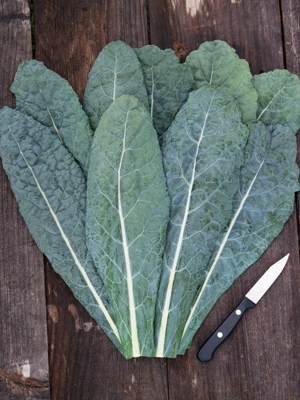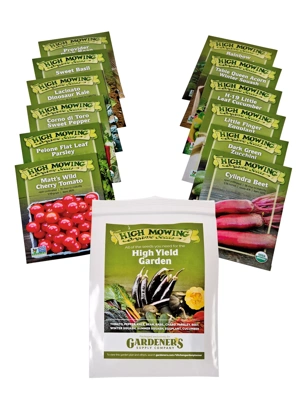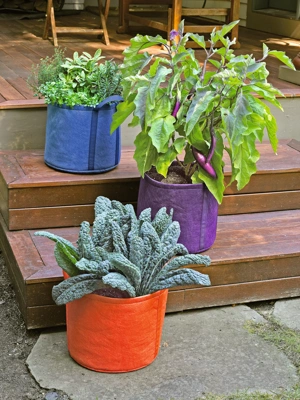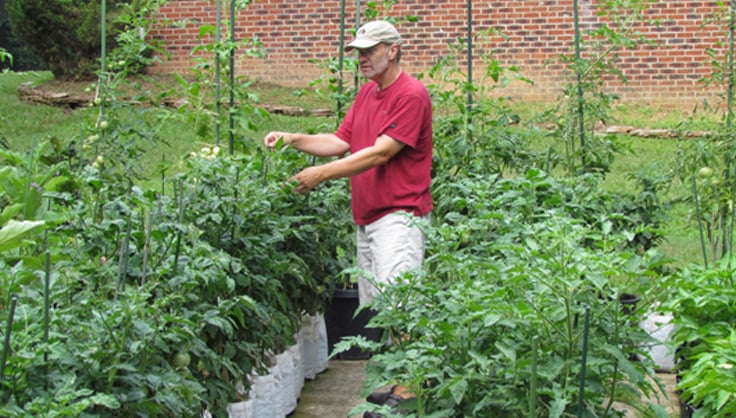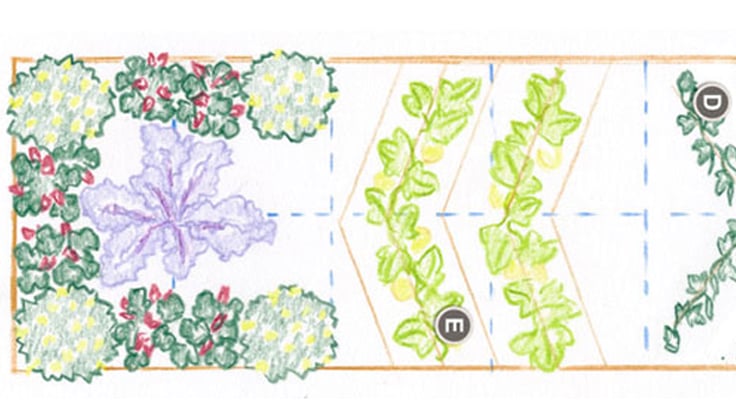Make Room For Kale
Plant more kale: how to source seeds and choose the right variety
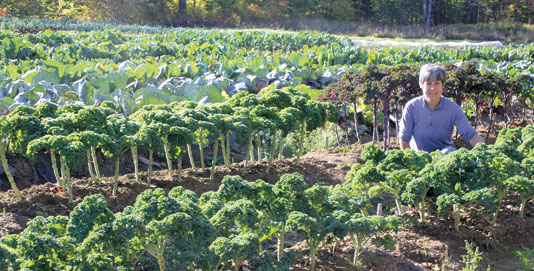 Monique, a gardener at High Mowing Seeds, tends several varieties of kale in the trials field. Photo: Sarah Cannon
Monique, a gardener at High Mowing Seeds, tends several varieties of kale in the trials field. Photo: Sarah CannonWhether served as kale chips, in a cheesy gratin, or simply steamed, kale has taken the vegetable world by storm. Finally shaking its reputation as a lowly salad bar garnish, its newfound popularity probably stems from its health benefits (high fiber, loads of vitamins), ease of culture, and, perhaps, a popular recipe for kale chips by Dan Barber of Blue Hill in New York. Kale can be grown in the tropics (with a little shade) just as easily as in the far north (with a little protection). It can be planted once and harvested all season, or succession-planted again and again for an extended harvest. Even the smallest gardens have room for kale — it's just a matter of choosing the right variety.
The one downside of all this leafy green goodness? Seed supply is limited. Because kale is a biennial crop that generally takes two seasons to produce flowers and seeds, it will take time for the seed industry to catch up to the trend. As a result of kale's rise to vegetable stardom, many seed companies sell through their inventory and scramble to find more seed. Place your seed order early for the best selection.
The most popular varieties will be the hardest to find - especially curly red and green hybrids, such as Winterbor, Ripbor and Redbor. Fortunately there are some new open-pollinated varieties that make excellent substitutes. Varieties include Meadowlark, Westlander, Dwarf Green Curled, and the vigorous, frosty-purple Olympic Red. If you haven't tried them before, consider the Russian and Lacinato types as well: Red Russian and White Russian offer exceptional cold-hardiness and have a tender texture that's excellent for steaming and stir-fries. Lacinato, also known as dinosaur kale or Tuscan kale, is perfect in raw kale salads and miso soups. Siberian kale has perhaps the tenderest leaves of all, with attractive curls that are gorgeous in salads.
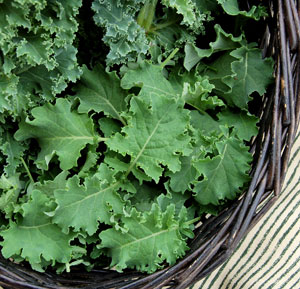 Vates Kale
Vates KaleA Kale for Every Gardener
One of the great things about all the kale-mania going on right now is that it's encouraging plant breeders to develop new varieties for the budding market. Each year the farmers at High Mowing Organic Seeds plant new varieties in side-by-side trials with classic favorites. The goal is to see how they compare in terms of flavor, growth habit, days to maturity and vigor. These trials help the team decide whether or not to include a variety in the catalog. The trials data, combined with information from growers and breeders, provide a more complete picture of a variety, including what conditions help it thrive. To that end, we've found that some varieties are exceptionally well-suited to particular uses.
Raised Beds and Containers
 Dwarf Green Curled Kale
Dwarf Green Curled KaleIn situations where space is limited, such as for gardeners growing kale in raised beds or large containers, look for varieties described as compact and productive. These will produce lots of greens without taking up too much real estate, and are less likely than big plants to become stressed by competition for nutrients, light and water. Try Dwarf Green Curled, a high-yielding, cold-tolerant variety that grows to about 18" tall, similar to Ripbor but with a slightly smaller habit. Another great option is Curly Roja, a compact 16-18" plant with purple-green leaves — similar to Redbor, a longtime favorite.
Microgreens and Baby Greens
If you're excited about growing microgreens (leaves harvested 12 to 20 days after planting in trays), I heartily recommend Red Russian. The immature leaves are light green with lavender stems and are beautiful on their own or in a mixture. The frilled leaf contrasts with the miniature curls of Green Kale, and the combination is a striking and delicious addition to salads. For baby greens (leaves harvested 20 to 30 days after planting) my favorites are Red Russian, White Russian, and Vates, a very compact variety ideal for late-season salads and overwintering. Direct sow seeds every one to three weeks throughout the summer for a continuous harvest of baby leaves. Kale germinates best at 65 to 75 degrees F; during the warmest part of the summer cool the soil by covering with cardboard for a week prior to planting and make sure that the seeds stay well-watered until they germinate.
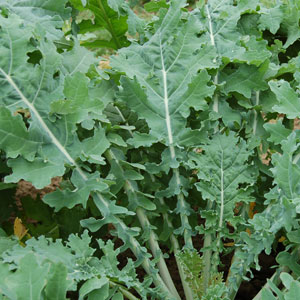 White Russian
White RussianSuccession Planting
If you love kale, try succession-planting, which will extend the harvest. Start the season with fast-growing White Russian, which tolerates the cold, wet soils of spring. Start seeds indoors about six weeks before the last frost date in your area. Two weeks before your last frost, start some Meadowlark curly kale and heat-tolerant Lacinato for summer salads and early fall soups. In areas with very hot summers, try interplanting summer kale with taller crops, such as tomatoes, corn, or beans to give the plants some shade kale and other greens do especially well with some shade in the heat of summer. Finally, about eight weeks before the first fall frost, start seeds of vigorous, frost-tolerant Olympic Red and Vates for fall and winter harvests. Kale thrives in mild winters, but can also produce sweet, tender leaves long into a cold winter if the plants are protected with row cover or are planted in an unheated greenhouse.
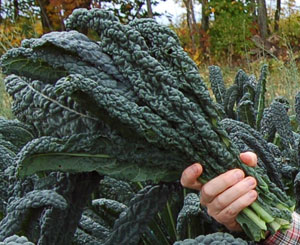 Lacinato kale, also known as dinosaur kale
Lacinato kale, also known as dinosaur kaleIf you discover that your favorites aren't available this year, think of it as an opportunity to learn about something new. And since I'm writing about kale (and getting hungry), here's a recipe for a delicious Three Greens Gratin you can make with kale for a satisfying winter meal. The recipe calls for Swiss chard, but the author, Martha Rose Shulman, notes that "you can play around with the mix of greens; switch out beet greens for spinach, or some of the chard for kale (kale will require a minute or two more of blanching)."
 Kale thrives in mild winters, but can also produce sweet, tender leaves long into a cold winter. Photo: Delia Gillen
Kale thrives in mild winters, but can also produce sweet, tender leaves long into a cold winter. Photo: Delia GillenLast updated: 01/04/2023
Print this Article:
Related items
Related Articles
Get the Dirt
Stay up to date on new articles and advice. Please fill out the information below.



